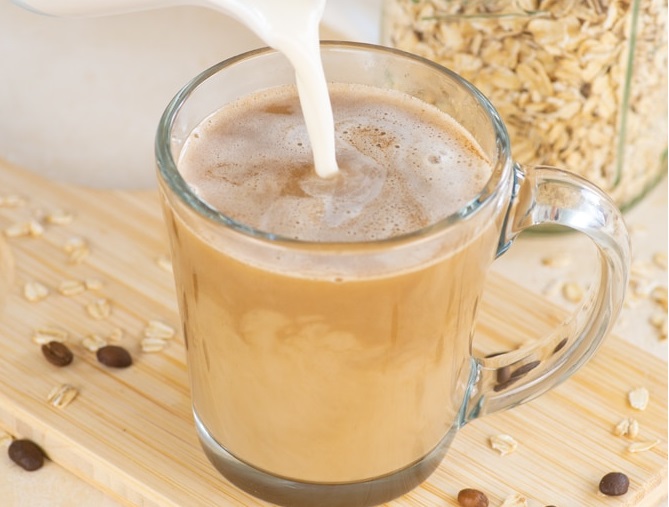
Oat milk has risen to prominence as a favorite among coffee enthusiasts who prefer dairy-free alternatives. Known for its creamy texture and mild, slightly sweet flavor, oat milk complements coffee well, making it a popular choice in cafés and kitchens worldwide. Its environmental footprint is also smaller compared to traditional dairy milk, adding to its appeal among eco-conscious consumers.
However, integrating oat milk into coffee can sometimes lead to a less than desirable outcome: separation. Many have noticed that when they pour oat milk into their coffee, it sometimes separates, leaving a layer of curds floating on top. This not only affects the visual appeal but can also alter the texture of the coffee, leading many to wonder about the cause behind this phenomenon.
Why Does Oat Milk Separate in Coffee?
The main culprits behind the separation of oat milk in coffee are acidity and temperature. Coffee is naturally acidic, and this acidity can cause the proteins in oat milk to coagulate, similar to how lemon juice curdles milk in recipes. When these proteins coagulate, they change the milk from a smooth liquid into lumps or curds.
Temperature plays a significant role as well. Oat milk, which is best stored and often used cold, reacts to the sudden heat of hot coffee. The rapid temperature change can destabilize the emulsion of fats and liquids in oat milk, causing the fats to separate and float to the surface. This is why you might see a layer of oil or cream on top of your coffee after adding cold oat milk.
Key Takeaways for Preventing Oat Milk Separation
To keep your oat milk from parting ways with your coffee, a few strategic choices can make all the difference. These steps not only enhance the consistency of your drink but also ensure every sip is as enjoyable as intended. Here are some key takeaways:
- Use barista-grade oat milk: These products are specifically formulated to handle the high temperatures of coffee without curdling.
- Adjust the temperature of oat milk and coffee: Warm your oat milk slightly before adding it to your coffee, or allow the coffee to cool for a few moments after brewing.
- Opt for low-acid coffee varieties: Coffees with lower acidity are gentler on oat milk, reducing the likelihood of separation.
Understanding the Science Behind Oat Milk Separation
Oat milk’s reaction in coffee boils down to its molecular composition—mainly fats, proteins, and sugars—and how these elements interact with heat and the acidic environment of coffee.
Composition of Oat Milk:
- Fats: Provide creaminess but can separate under heat.
- Proteins: Crucial for texture; they coagulate in acidic conditions, leading to curdling.
- Sugars: Add sweetness and can influence how the proteins and fats stabilize under heat.
Impact of Heat and pH:
- Heat: Sudden heat can destabilize the emulsion of fats and liquids in oat milk, causing the fats to separate and float to the top.
- Acidity: Coffee’s natural acidity can alter the structure of oat milk proteins, promoting separation.
Practical Tips to Prevent Oat Milk Separation
Navigating the challenges of oat milk in coffee doesn’t have to be daunting. With these practical tips, you can enjoy a smooth, creamy coffee experience every time.
Temperature Management
One of the simplest yet most effective ways to prevent oat milk from separating is to manage the temperature. Before pouring it into your coffee, gently warm the oat milk to reduce the temperature shock. This can be done by heating it in the microwave for a few seconds or on the stove. Just make sure it’s warm, not hot, to avoid any cooking of the milk which could lead to other issues.
Acidity Adjustment
The acidity of your coffee plays a crucial role in how oat milk behaves once mixed. Opting for coffee with lower acidity can significantly reduce the chances of separation. Low-acid coffee options are available, or you can tweak your brewing method to reduce acidity. For instance, cold brewing naturally produces coffee with less acid.
Pouring Techniques
How you combine oat milk with coffee can also impact whether it separates. Instead of pouring hot coffee into a cup of cold oat milk, try reversing the order. Pour oat milk into your cup first, then slowly add coffee. This method, known as tempering, gently acclimatizes the oat milk to the coffee’s temperature, helping prevent separation.
Product Selection
Selecting the right type of oat milk is critical. Look for products labeled as “barista” or “professional” grade. These oat milks are specifically formulated to perform better under the heat and acidity conditions typical of coffee brewing. They often include stabilizers that help maintain emulsion and prevent curdling.
Advanced Coffee Brewing Techniques
Different brewing methods can affect how well oat milk mixes with your coffee, influencing whether it separates or integrates smoothly.
Espresso: When making espresso-based drinks like lattes or cappuccinos with oat milk, use a steam wand to froth the milk. This not only heats the milk gently but also incorporates air, making it less likely to curdle when mixed with the intense espresso.
French Press: For those using a French press, allow your coffee to cool slightly before adding oat milk. The gentle plunge of the French press doesn’t agitate the coffee too much, which is beneficial since vigorous stirring can promote separation.
Cold Brew: Cold brew is an excellent method for oat milk coffees because of its naturally low acidity. The cool brewing process ensures that the coffee is less likely to cause the oat milk to curdle, making it ideal for smoother coffee drinks.
FAQs
Can oat milk be used in coffee without separation?
Yes, oat milk can be used in coffee without experiencing separation. The key is managing the temperature and acidity of the coffee, as well as choosing the right type of oat milk, such as barista editions that are specifically formulated to handle the heat without curdling.
Does oat milk separation affect the taste of coffee?
While the separation of oat milk mainly impacts the visual and textural aspects of the coffee, it can slightly alter the taste. Clumps of oat milk might not blend smoothly, giving a slightly uneven flavor distribution in your coffee.
Are there differences in separation among oat milk brands?
Yes, there are differences. Some brands of oat milk are more prone to separation due to their specific formulations. Brands that offer “barista” or “professional” grades of oat milk generally include stabilizers that help prevent separation and curdling when mixed with hot coffee.
Final Thoughts
Understanding the factors that lead to oat milk separation in coffee can greatly enhance your brewing experience. By choosing the right type of oat milk, adjusting the coffee’s temperature and acidity, and employing proper pouring techniques, you can enjoy a smooth, delicious dairy-free coffee at home.









